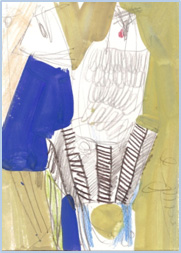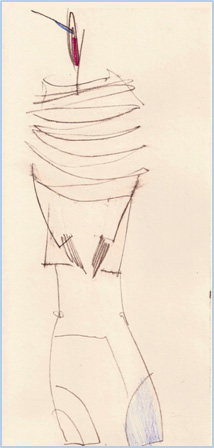Модельерская графика, или как подготовить эскизный проект коллекции одежды?
Между художником и его творением есть какая-то таинственная связь. Вероятно, это время духовного рождения художественного произведения. И самая незначительная деталь – цвет ластика или узор из проводов на полу – имеет значение. А, может быть, это Вселенная собирает свои силы в едином стремлении СОЗДАТЬ. И в помощь создающему.
Из диплома.
Разработка эскизного ряда – основная работа любого дизайнера. Проектирование изделия/ий по заданной теме в большой степени определяет все следующие этапы – макетирование и выполнение в материале. Справедливо будет предположить, что осознанный и грамотный подход к проектированию коллекции возможен при сведении таких условий, как профессиональная художественная подготовка и навык прогнозирования модного процесса.


Чтобы остаться художником и не сводить все рассуждения о проектировании к определённому набору приёмов, я хочу поделиться своим личным опытом.
Вне всяких сомнений, один простой эскиз может стать целой коллекцией – одежда, создаваемая на основе художественного эскиза, никогда себя не повторяет. Моя убеждённость не пустые слова, она подкрепляется работой – макеты, воспроизводящие эскиз, существенно могут отличаться друг от друга по способу формообразования и технологическим приёмам. Поражает воображение разнообразие, вносимое цветом, фактурой, плотностью – характеристиками материалов, из которых макет станет изделием. И это чистая магия. Здесь я только наблюдатель…
Художественный эскиз – и самостоятельное произведение искусства, и этакая «карта сокровищ», в ней все пути ведут к драгоценным находкам. В сравнении с ним, технический – буквален, однозначен. Не попадает под категорию художественной и эстетической ценности. По причине своей уплощённости используется на производстве, где все процессы укладываются в строгие схемы. Поэтому я противник компьютерных программ, мешающих помогающих модельерам проектировать одежду.
Самое творческое и любимое – с чего ВСЁ начинается – задание и «чистое поле» модельного ряда. Уже имея задание, стоит определяться с набором изобразительных средств и задаваться мыслью, как воплотить НЕЧТО ПРОЕКТИРУЕМОЕ художественно и технически. Я знаю, что выбор «графического языка» настолько богат, и ещё каждое новое «поколение» молодых модельеров привносит свою оригинальную идею, что это не составляет труда. Мы, например, пользовались древками кистей, и марлей, и разными губками и спонжами, чтобы создать фактуру меха. Обычная кисть даёт такой спектр возможностей, что на этой ноте я и закончу свои детальнейшие разъяснения по выбору графических средств.
Модельный ряд – горизонтальное поле разных форматов (1/2, 1/3, 2/3 от основного формата А4, А3 и т.д.) Теме телодвижений стоило бы посвятить отдельный пост. Характер их зависит также от задания, от мировосприятия дизайнера. Однажды, во время учёбы, нам дали тему: «Обнажённое тело. Стекло». Сложно вообразить себе в одном «проектируемом объекте» текучую пластичность женского тела и хрупкую статичность стеклянных изделий. Но этот сплав необходимо было изобрести!..
В этой общей композиции модельного ряда участвуют все графические формы и цвета, и пустоты. Пространство подчиняется ритму линий, пятен и себе самому. Проектировать надо всё «поле» сразу, исходя из поставленной задачи и пластики телодвижений. Такой подход тренирует «чувство чистого листа», (не знаю, как выразиться точнее), – взаимообусловленность, симметрия и компонентность форм проявляются в работе наиболее выразительно. Это особенное видение композиции, которое есть всё поле модельного ряда, приходит не сразу. Напряжённый труд и вдохновенное состояние ума и сердца помогут модельеру на его пути.
В конечном счёте, из предложенного ряда моделей выбирают те, по которым будут созданы макеты, а затем готовые изделия. Но, конечно, если не существует препятствия в виде недостатка средств, то нужно сделать макет/макеты для каждого эскиза.
Самые неожиданные и интересные открытия ожидают модельера именно в самый момент проектирования. Ни один конструктор не сможет так подойти к поставленной задаче, чтобы сначала «отключиться» от всего заранее известного или предполагаемого в одежде, а потом изобрести что-то совершенно иное, найти нестандартное решение.
Это то, о чём говорит Jean-Marc Gady: «В погоне за новыми эмоциями я пытаюсь разрушить старые коды. В соответствии с моим творческим процессом, когда я готовлю свой ум к проекту (будь то ваза или пылесос), я пытаюсь забыть эстетическое прошлое предмета и вместо этого экспериментирую с ним как бы с «чистого листа», постигая его в других видах».

Designer’s Graphics, or How to prepare a sketch design of a collection of clothes?
There is some mystical unity between the artist and his work, conceived, perhaps, in the very moment of creation. At this time even the smallest thing, whether it is the colour of the eraser or the elaborate pattern of wires on the floor, can produce a tremendous effect. Perhaps it is the Universe itself that is collecting all its forces in one single attempt of creation, and, therefore, is helping the artist in his toil.
From the diploma.
The development of sketch series is the main work for any designer. The designing of a product/products on a given topic determines to a large extent the success of all the following steps –the maquetting and the realization in fabric. It is fair to assume that a conscious and competent approach to the designing of a collection is possible only if the designer has professional artistic skills and the skill to predict the fashion process.


To remain an artist and not to reduce all the arguments about the design to a set of techniques, I want to share my personal experience.
Without doubt, a simple sketch can become a whole collection – clothes created on the basis of an artistic sketch never repeat each other. My belief is not just words, it is supported by my work – the maquettes that reproduce a sketch may have significant differences from each other, in the way of forming and manufacturing methods. The diversity introduced by the color, texture, density – the characteristics of the materials which turn the maquette into a product – boggles the mind. And it's pure magic. Here I am only an observer...
An artistic sketch is both a separate work of art and a sort of a "treasure map", where all the ways shown lead to precious findings. A technical sketch, in comparison, is literal, straightforward. It doesn’t seem to fall into the category of artistic and aesthetic value. Because of its flatness, it is used in production, where all the processes fit into neat schemes. Therefore, I am opposed to computer programs that “help” designers to design clothes – and, in fact, just create obstructions.
The most creative and beloved work – which makes it ALL start –is beginning with a task and the "open field" of the model range. When the task has already been given, it’s time to decide which drawing tools to use and to set your mind on how to embody SOMETHING DESIGNABLE artistically and technically. I know that the choice of "a graphic language" is so rich, and, which is more, each new "generation" of young designers brings its own original idea, that it makes no difficulty at all. For example, we used brush shafts, and gauze, and various sponges to create the texture of fur. A usual brush gives such a wide range of possibilities that on this note I will finish my detailed explanations of the choice of graphical tools.
A model range is a horizontal sheet of paper, which can have different sizes (1/2, 1/3, 2/3 of standard sheets A4, A3, etc.) Body movements is a topic in its own right. Their peculiarities depend on the task and the perception of the designer. One day, while studying, we were given the topic: "Naked body. Glass". It is difficult to combine in one "designed object" the flowing plasticity of a female body and the fragile static of glass figures. However, this alloy was to be invented!..
The overall composition of a model range includes all graphical shapes of both colour and emptiness. The space is subjected to the rhythm of lines, spots and itself. All “field” should be designed at once, according to the task and the plastiсity of body movements. This approach trains the "sense of a blank sheet" (I do not know how to be more precise) – the interdependence, symmetry and componency of the forms appear in the work in the most expressive way. This particular vision of the composition, which is the whole field of the model range, does not come at once. Hard work and the inspiration of mind and heart will help a designer on his or her way.
In the end, some of the proposed models are chosen – they are used to create maquettes and then end products. But of course, if there are no obstacles such as lack of funds, it is necessary to make a maquette/maquettes for each sketch.
The most unexpected and exciting discoveries await the designer at the very moment of sketching. No constructor will ever be able to approach the task is such a way: firstly to "switch off" from all known or suspected before in the clothing, and then to invent something absolutely different, to find an innovative solution.
This is what Jean-Marc Gady talks about: “In the pursuit of new emotions I'm trying to break old codes. According to my creative process, when I am preparing my mind for a project (whether it is a vase or a vacuum cleaner), I'm trying to forget the aesthetic past of the object and experiment with it instead, as if it were with a "blank sheet", perceiving it in other forms."
